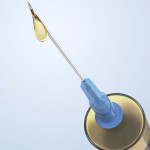
While there are a range of injectable filler complications that can occur (bruising, asymmetry, overcorrection, undercorrection, misplacement, swelling) these are generally temporary issues that are self-solving problems with time. The one more problematic and often not easily solved filler problem is that of nodules or lumps. Persistent lumps could just be just too much filler or an inflammatory reaction to the filler or a chronic infection as a result of the filler. It is important to first establish what type of injectable filler nodule problem that exists before embarking in treating it. The classification of nodules can be divided into acute (occurring with 2 days of the treatment) and subacute. (occurring up to 2 weeks or more after treatment)
Acute filler lumps that appear right after treatment are most commonly due to a small hematoma. It is a needle that is used for placement, which can transect small vessels, and high injection forces can also cause local bleeding. Such effects are most commonly seen around the eyes and lips where the tissues are thin and highly vascular. An acute lump that may also have bluish discoloration is when a filler lump is too close to the skin. Due to the Tyndall effect, there is a preferential scattering of blue light back to the observer’s eye. These type of filler lumps, which may be aesthetically disturbing, are usually self-solving over several weeks to a month. If the patient wants a faster response, the use of hyaluronidase will enzymatically dissolve the unwanted material if it is a hyaluronic acid-based filler.
Lumps that appear weeks later are either due to clumping of particulated material (Radiesse) or due to some form of reaction or inflammatory response.The key differentiator is whether it is associated with redness, heat and tenderness, all signs of infection. If it is just a benign clump, passing a small gauge needle in and out of the clump (needle dispersion) with the injection of some hyaluronidase will help break it up. When the filler lump is infectious, it should then be treated with oral antibiotics. Because the innoculum is likely staphyococcus from the skin, Kelfex may be sufficient. But if it fails to show a quick response, changing to a flouroquinolone like Cipro may be more effective as it can penetrate resistant biofilm layers better. if it is a growing red lump, needle puncture to provide some purulent drainage may be needed in addition to oral antibiotics. While the risk of infection from injectable fillers is remarkably low, it can still happen. Removing makeup, cleansing the skin and minimizing needle sticks are all good strategies to avoid this potential problem.
Injectable filler lumps are not rare and most are benign and self-solving. But clumping of particulated materials and inflammatory/infected nodules will usually need treatment for resolution.
Dr. Barry Eppley
Indianapolis, Indiana


